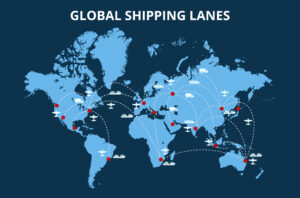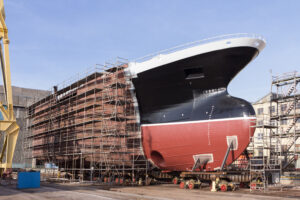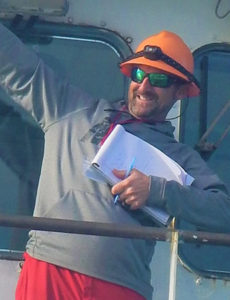- June 15, 2021
- Industry, Marine News
The amount of money being put into meeting the 2050 air cleanliness goals of the Paris Accords and the IMO is staggering. Every week we read more news items and long reports on studies and research and experiments on new technology.
In a swing of the energy pendulum, atomic energy is returning as a form of marine power. Fast reactors have been in development for quite a while with a company, TerraPower (Bill Gates, founder), working on a molten chloride fast reactor (MCFR) since 2008. A British company, Core Power, has designed a modular marine Molten Salt Reactor (m-MSR). Core Power is working with Terra Power, a university, the U.S. government atomic energy agency, several other nuclear design groups, and shipping interests to advance such a modular unit for powering ships. The large container ship company, X-press Feeders, is an investor. (Maritime pundits are not sure if the company is taking this track to future zero emissions or has made so much money in the last year, as have other container ship operators, they have to put some of it somewhere. This investment gives them green cred.)
“You can’t squeeze blood out of a tulip.”
Archie Bunker
The MSR runs on a mixture of liquid salt and uranium oxide. The liquid fuel also acts as the reactor cooling agent and is 95% fuel efficient – far above the efficiency of any other fuel source. Atomic units create heat which in turn powers steam driven turbines for direct power, or via powering generators for electrical power.
This zero-emission system can also provide clean power, as is the plan with wind farms, to produce green ammonia and green hydrogen; however, it is anticipated that it will be 10-15 years before this type of reactor will be suitable for larger ocean-going ships.
We have atomic energy now as an ecologically sound source of power. Meanwhile, Japan is building numerous coal-fired power plants to replace the failed Fukushima plant. It is not quite as irrational as it sounds as the Fukushima (and other nuclear power plants and nuclear-powered ships) use different types of fuel and cooling systems from the Molten Salt systems with fewer failsafe principles. Japan also needed to replace electrical power sources immediately and coal power plants could be built and fueled quickly and relatively cheaply. At the same time, Samsung Heavy Industries and the Korea Atomic Research Institute are also working on liquid salt reactors for ship and offshore power.
Revisiting Sources of the Green $ for Going Green
I recently watched a webinar presented by the IVSC and Duff & Phelps on valuing ESG (Environmental-Social-Governmental) in companies. It was very informative, and if you are involved with business valuation, worth watching. One of the points made was that institutional investors are taking the long-term view with their investments, so they are concerned with a company’s investment in ESG. A very large percentage of all investors are fine with a lack of short term returns if the profits are being turned back into ESG investments for better long-term returns. Businesses must realize that if they do not make adaptations in environmental impact and social impact they may end up without customers and employees. Currently there are reportedly over 400 stocks that claim ESG status. The problem is in measuring the value in a company of E and of S and of G.
On the maritime side it is somewhat easier to measure ESG, or at least Environmental. The IMO, the EU, and individual port states have regulations on engine emissions and ballast water discharge – two of the largest environmental areas impacted by shipping. The regulations have been written by numerous governmental bodies and are therefore not all uniform. There are ongoing projects to bring uniformity to these international shipping regulations but that will take some time. Meanwhile, shipowners and ship operators are self-reporting compliance with emission regulations, or maybe more accurately, reporting greatly reduced emissions or even zero emission. The problem is that there is yet no agreed set protocol for measuring greenness. One can proclaim greatly reduced CO2 emissions while evading the question of particulate matter or methane. Few want to go into the cradle to grave view of ecological purity. Battery electrical power is clean – if you don’t look too closely at the mining and manufacturing of batteries and their subsequent disposal. Same with wind power blades. Both may be a subject of future blog posts.
There are several groups of interested parties involving governments, universities, NGOs, and end users that are working on sets of data measurements that encompass needs and regulations and are transparent. Even class societies are working up systems to grade vessels so that investors can feel comfortable in reviewing the acceptability of a ship into the investor’s environmental impact portfolio.
Once upon a time, in the classic 1967 movie The Graduate, Mr. McGuire said to Benjamin Braddock just one word, “Plastics”.Today, where nothing is confined to one word, it could be two words, “Carbon Credits”. Or maybe “Emission Trading”. Unlike plastics, it is the buying and selling of dirty and clean air, a new way to make money.It is also a bit like the current rules for agreements like the Poseidon Principles. (See earlier blog Long Green For Long-Lived Greens and its coverage of the Equator Principles and the Poseidon Principles). If you take a very jaundiced view, one can operate smoke belching coal burners in your fleet as long as you can offset them with some sail powered boats. If you are carbon heavy you buy some “clean air” from someone who is carbon light. As one scientist said, it is a bit like having a diet soda to cancel out the cheeseburger in your hand. Only it’s not that simple.
Carbon is an inventory problem and money will be made in handling that inventory. Carbon “intangibles” will be bought and sold. Companies will also make money in the transport and disposal of carbon. Carbon tankers are being built to deliver unwanted carbon to injection disposal storage sites. Some of these investors are oil companies where there will be credits for carbon disposal and the carbon will be injected into oil wells to increase production.
Producing ships that will have zero emissions is very expensive but a fair number of companies around the world will also profit nicely from the science and products that will get us there. Capital goes where it will get a return. Investors are investing in projects that involve climate control so believe these are sound investments.
Investors do not want to invest where the investment may not be sound. People’s perceptions, and national and international law, are going against fossil fuels. Automobile builders worldwide are moving toward electric fleets in the next 10 to 15 years. Would it make sense to make a 20-year loan to a gasoline engine manufacturer or gas station, or instead to a battery manufacturer or solar power installer?
For now, as appraisers of marine assets, it will be difficult to measure the E for shipping companies. It will be more about us seeing how a vessel complies with current regulations on engine types and their emissions, ballast water treatment installations, and for larger ships, their ESI (Environmental Ship Index).
A bit more on windfarms
The last blog on windfarms got a lot of interest. I came across some recent facts that may be of interest to some of you and show (ahem) which way the wind is blowing.
In 2020 the amount of electrical power produced from coal was 293 TeraWatt hours. The amount of power from wind 373 TWh.
The reason that wind power is growing is that the cost per unit is dropping. One of the reasons the per unit cost is dropping is the increase in the size/power of wind farm towers. While the expense of each tower jumps, it is still less than the efficiencies each produce.
The present king of the wind turbine hill is the GE Haliade-X. It is the model that makes up the new Borssele III and IV wind farm off the Netherlands coast and will be used in Virginia.
The output of this model can range from 12 to 14 MW with a slight increase in GWh and efficiency rating as the output increases. They are classed as IEC I, which is for the strongest expected wind conditions.
The total height is 814’ (248m) and a rotor diameter of 722’ (220m). A single blade is 350’ (107m) long.
Such fixed platforms are good up to water depths of around 200’ (60m). Various companies with experience in tethered floating offshore platforms for the oil industry are designing for tethered wind farms. Tethered floating wind platforms have been compared to putting a bus on top of an 800’ tall pole making it float and be stable in expected wind and wave conditions.
For those with an engineering mind, more details on wind farm classification and regulations can be found by looking up IEC64100. Some of the U.S. design regulations for offshore windfarm construction can be found in ISO standards that were drawn up for offshore oil structures.
An Interesting Economics Aside
World trade with China continues. Raw materials on tankers and bulk carriers come into Chinese ports, and containers of finished products go out to the world. This trade is wonderful for people everywhere being able to afford inexpensive products but not so wonderful for the import/export balance of trade for scores of countries.
Is it sustainable?
COVID 19 shook up the world’s Just-In-Time inventory system. Many countries and their industries realized that they will have to rethink their supply chain systems as the future could bring other surprises to their systems, natural or political surprises.
In 2020, China entered a trade war with Australia over Australian comments on Chinese treatment of its citizens and the source of COVID-19 (although problems had been growing for several years). Hundreds of bulk carriers became stranded off the west coast of China when China banned the import of Australian iron ore and coal. Then there was the container ship, EVER GIVEN, blocking the Suez Canal and monthly news stories of container ships losing containers due to storm or fire. Currently (early June) there are around 40 container ships backed up at Yantian Port in China which is the source of 25% of the container trade with the U.S., due to a COVID-19 shut down. Experts say it will take 2 to 5 weeks to clear the backlog once the port is opened.
The United States is moving to protect the sources of vital commodities by mining or manufacturing them in the country or via closer and/or more reliable sources. Other countries and corporations worldwide have the same concerns.
In 2013, China started the Silk Road Economic Belt, now known as the Belt and Road Initiative (BRI). As the leader and creator of the Asian Infrastructure Investment Bank (AIIB), BRI has made millions of dollars in loans throughout China, Asia, and Africa, mostly to developing countries and most transportation related, such as airports, railroads, and ports. Many of the loans to these countries were originally interest free but were asset based with land, minerals, or cash as collateral. Due to world economics, particularly COVID-19, many of these loans are reportedly non-performing with some of the projects abandoned.
So, again, is the current trade and trade routes with China sustainable? Can China continue its past growth as a leading economic power?
Chinese media speaks of the “gray rhino”. It is China’s huge debt crisis that has been growing for years. After decades of debt-fueled growth the country’s debt reportedly totals about 280% of GDP. This is a problem for the Communist Party that has ruled by providing steady economic growth. The debt accumulation was an easy way to grow the economy and please the population and extend its influence beyond its borders. However, the wild economic growth in China produced not just national governmental debt, but also corporate, household, and the debt of regional and local governments, with the latter having few tools to provide income when the rules come from Beijing.
The Chinese government is now considering taxing home ownership. It shouldn’t be called a property tax as the government owns all the land. Taxation will be no more popular in China than it is anywhere else in the world. A recent article in Oilprice.com reports that China is cutting off subsidies to solar and land wind growth. This in a country that has had significant problems with air pollution and has set goals for GHG reduction yet has a very important coal industry. Some commentators believe this move is being forced by the country’s economic position and cutting the cost of solar and wind saves money with less political risk.
China will continue to be a very major player in world trade and economics. They will continue to be in the top three for ship construction with nationalized shipyards able to be very competitive against other Asian and western shipyards. They have also become an increasing participant in ship financing, but the economic growth rate of the past is probably over, and China may have to turn more attention to the economy within the country.
All of these economic shifts are of interest to our hull and machinery surveyors and appraisal team here at DLS.
The growth of giant container ships and the few ports able to accept them is making the economics of the United States/Canadian America’s Marine Highway coastal shipping plan, i.e., short sea transportation, more feasible. Tug/barge container feeder services have begun.
While still working with good customers in the inland fuel/chemical trade, DLS is also working with offshore wind farm interests.
Through our regional agency for Lloyd’s, we are also very aware of the changes in product movements and the risks in packaging and shipping.
In a modern multi-faceted marine survey and consulting business it is no longer just about knowing steel and machinery.











